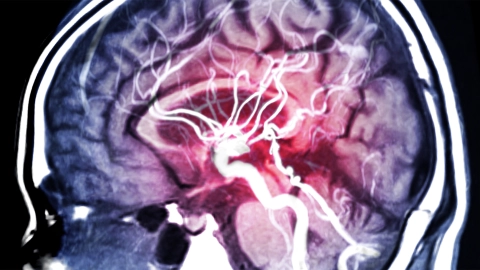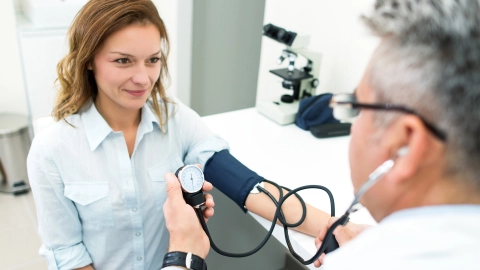Conditions Abdominal aortic aneurysm
ICD codes: I71 What are ICD codes?
If part of the abdominal aorta stretches and bulges outward, doctors refer to this as an abdominal aortic aneurysm. It occurs more frequently in men than women. In most cases, an abdominal aortic aneurysm doesn’t cause any serious problems. If it ruptures, however, this is an emergency that must be treated immediately.
At a glance
- If part of the aorta in the abdomen (tummy) stretches and bulges out, this is known as an abdominal aortic aneurysm.
- It usually doesn’t cause any symptoms and remains unnoticed.
- If the abdominal aortic aneurysm ruptures (breaks open), this is a life-threatening emergency.
- The size of the aneurysm and other risk factors indicate how likely a rupture is.
- About 2% of all men between the ages of 65 and 75 have an abdominal aortic aneurysm. Women are much less likely to have one.
- Men over the age of 65 can avail of screening for abdominal aortic aneurysms as part of their health check-up.
Note: The information in this article cannot and should not replace a medical consultation and must not be used for self-diagnosis or treatment.

What is an abdominal aortic aneurysm?
The term abdominal aortic aneurysm describes an abnormal enlargement of part of the abdominal aorta.
The aorta is the artery that carries oxygen-rich blood from the heart to the rest of the body. The part of the aorta that runs through the abdomen is called the abdominal aorta. It usually has a diameter of about 2 cm. If one part of the abdominal aorta becomes enlarged and bulges outward to a diameter of more than 3 cm, this is known as an abdominal aortic aneurysm.
An abdominal aortic aneurysm typically doesn’t cause any symptoms and most aneurysms are harmless. But there is a risk of the aorta suddenly rupturing (breaking open) if an aneurysm keeps on expanding. That is an emergency situation and life-threatening.
What are the symptoms of an abdominal aortic aneurysm?
Abdominal aortic aneurysms seldom cause any symptoms and often go unnoticed.
Larger aneurysms of the abdominal aorta may cause symptoms such as back ache, abdominal pain or pain in the sides of the body.
If the abdominal aorta ruptures, it causes sudden back pain that radiates to the sides or groin. In the event of a rupture, a large amount of blood is lost, which may cause dizziness, loss of consciousness and, eventually, circulatory collapse.
What causes an abdominal aortic aneurysm?
An abdominal aortic aneurysm may arise if the vessel wall becomes less elastic, for example, as a normal part of aging or if there is too much pressure on the blood vessel, for instance due to high blood pressure. Smoking also increases the risk of developing an abdominal aortic aneurysm.
If one part of the vessel wall starts bulging, it tends to continue to expand, and the aneurysm grows larger over time.
What factors increase the risk of developing an abdominal aortic aneurysm?
Several factors increase the risk of an abdominal aortic aneurysm. These are listed below:
- Age: the risk increases with age. Most people who have an abdominal aortic aneurysm are over 65 years old.
- Smoking: smoking is the most important risk factor over which a person has control.
- High blood pressure or coronary heart disease: these also increase the risk of an abdominal aortic aneurysm.
- Blood lipids: high levels of blood lipids (blood fats) increase the likelihood of an aneurysm developing.
- Genetic predisposition: people who have fair skin or who have close relatives who have had an abdominal aortic aneurysm are at greater risk.
Sex also plays a role, with abdominal aortic aneurysms predominantly affecting men.
How often does an abdominal aortic aneurysm occur?
About 2 percent of all men between the ages of 65 and 75 have an abdominal aortic aneurysm.
Prevalence increases with age. Women are much less likely to have an abdominal aortic aneurysm.
How does an abdominal aortic aneurysm develop?
In most cases, an abdominal aortic aneurysm causes no symptoms and remains harmless. If it widens, this usually only happens at a slow rate.
Only some aneurysms become so large that there is an increased risk of the aorta suddenly rupturing. If the aorta ruptures, a large amount of blood leaks into the abdominal cavity – which is a life-threatening emergency.
The risk of an aneurysm rupturing is higher if the aneurysm is growing rapidly or if it is at least 5.5 cm in diameter. It is roughly estimated that abdominal aortic aneurysms with a diameter of more than 5.5 cm will rupture within one year in about 3 to 6 percent of men.
How is an abdominal aortic aneurysm diagnosed?
Abdominal aortic aneurysms are diagnosed using ultrasound imaging. The diameter of the abdominal aorta can be measured in this way. If the diameter of the aorta is greater than 3 cm, it is considered to be an aneurysm.
If an abdominal aortic aneurysm is causing symptoms, it is normally detected during testing to investigate the cause of these.
Can screening ensure early detection of an abdominal aortic aneurysm?
Early detection of an abdominal aortic aneurysm is possible using ultrasound imaging. Surgical intervention can then prevent large aneurysms from becoming large enough to rupture. If smaller bulges are detected, these can be checked regularly to see whether they are growing, and how quickly.
It has been shown that screening for men over the age of 65 lowers the risk of an abdominal aortic aneurysm rupturing and causing death. Only one high-quality study has investigated aneurysm screening tests for women. It shows that screening doesn’t have any advantages for women.
Important: Screening also has disadvantages. If doctors detect an aneurysm, it may be surgically repaired even though it may never have led to any health problems for the patient. In other words, screening may result in overdiagnosis. In addition, the surgical procedure itself may cause serious complications. Moreover, it may be very distressing for someone to discover that they have an aneurysm.
More information on the early detection of abdominal aortic aneurysms can be found in the brochure of the Joint Federal Committee (B-GA).
How is an abdominal aortic aneurysm treated?
Various factors will determine whether an abdominal aortic aneurysm will benefit from treatment and which form of treatment is most suitable. This will mainly depend on the size of the aneurysm, but also on how it develops and on the patient’s general health.
Smaller abdominal aortic aneurysms that have a diameter of less than 5.5 cm are typically checked on a regular basis.
Smokers are usually asked to quit if possible because smoking can cause the aneurysm to grow. People who have risk factors, such as high blood pressure or high blood lipid levels, are advised to seek treatment for those conditions. However, it is not yet clear whether medication such as drugs used to lower blood pressure or cholesterol can slow the growth of an aneurysm and lower the risk of rupture.
If the risk of rupture is high, surgery is the only preventive measure. There are two options:
- Open surgery through an abdominal incision (cut): the aneurysm is opened, and replaced by an artificial vessel (graft).
- Endovascular procedure through a small incision in the groin: a small tube (stent) is put through the incision into the artery, pushed along to where the aneurysm is, and implanted in the aneurysm.
Both of these procedures are associated with risks, and should be assessed and evaluated individually. As well as the risks associated with a surgical procedure, there is a possibility that the aneurysm may suddenly rupture.
More detailed information about abdominal aortic aneurysms, for example when an operation is appropriate, can be found at gesundheitsinformation.de.
What is involved in rehabilitation following surgery for an abdominal aortic aneurysm?
Open surgery on the abdominal aorta is a major procedure. Follow-up rehabilitative therapy following surgery for an abdominal aortic aneurysm offers people an opportunity to slowly get back to everyday activities and return to their normal lives.
The goal of rehabilitation is to minimize the negative effects of the surgery and improve quality of life.
What is important to know about everyday life with an abdominal aortic aneurysm?
Being diagnosed with an abdominal aortic aneurysm may trigger contradictory emotions. Some people are happy that their aneurysm was discovered, and the check-ups help make them feel safe.
Others would rather have not found out about the aneurysm. Knowing about it can be scary and troubling.
Many people with a diagnosed abdominal aortic aneurysm have to continue living their lives knowing that they are at risk. Symptoms such as abdominal pain can be frightening, as they are often thought to be associated with the aneurysm, even if that’s not actually the case. Many people affected stop doing certain things in everyday life out of fear. They become more cautious and avoid physical exertion to avoid an abdominal aortic aneurysm rupturing.
- Ali MU, Fitzpatrick-Lewis D, Kenny M et al. A systematic review of short-term vs long-term effectiveness of one-time abdominal aortic aneurysm screening in men with ultrasound. J Vasc Surg. 2018 Aug;68(2):612-623. doi: 10.1016/j.jvs.2018.03.411. PMID: 30037679.
- AlOthman O, Bobat S. Comparison of the Short and Long-Term Outcomes of Endovascular Repair and Open Surgical Repair in the Treatment of Unruptured Abdominal Aortic Aneurysms: Meta-Analysis and Systematic Review. Cureus. 2020 Aug 12;12(8):e9683. doi: 10.7759/cureus.9683. PMID: 32923276; PMCID: PMC7486022.
- Antoniou GA, Antoniou SA, Torella F. Editor's Choice - Endovascular vs. Open Repair for Abdominal Aortic Aneurysm: Systematic Review and Meta-analysis of Updated Peri-operative and Long Term Data of Randomised Controlled Trials. Eur J Vasc Endovasc Surg. 2020 Mar;59(3):385-397. doi: 10.1016/j.ejvs.2019.11.030. Epub 2019 Dec 30. PMID: 31899100.
- Deutsche Gesellschaft für Gefäßchirurgie e.V. (DGG). Screening, Diagnostik, Therapie und Nachsorge des Bauchaortenaneurysmas. S3-Leitlinie. AWMF-Registernummer 004-014. 07.2018.
- Golledge J, Singh TP. Effect of blood pressure lowering drugs and antibiotics on abdominal aortic aneurysm growth: a systematic review and meta-analysis. Heart. 2021 Sep;107(18):1465-1471. doi: 10.1136/heartjnl-2020-318192. Epub 2020 Nov 16. PMID: 33199361.
- Guirguis-Blake JM, Beil TL, Senger CA et al. Primary Care Screening for Abdominal Aortic Aneurysm: A Systematic Evidence Review for the U.S. Preventive Services Task Force. (AHRQ Evidence Syntheses; No. 184). 12.2019.
- Guirguis-Blake JM, Beil TL, Senger CA et al. Primary Care Screening for Abdominal Aortic Aneurysm: Updated Evidence Report and Systematic Review for the US Preventive Services Task Force. JAMA. 2019 Dec 10;322(22):2219-2238. doi: 10.1001/jama.2019.17021. PMID: 31821436.
- Institut für Qualität und Wirtschaftlichkeit im Gesundheitswesen (IQWiG). Ultraschall-Screening auf Bauchaortenaneurysmen: Abschlussbericht. IQWiG-Berichte – Nr. 294. Auftrag S13-04, Version 1.1. 04.2015.
- Institut für Qualität und Wirtschaftlichkeit im Gesundheitswesen (IQWiG). Versicherteninformation zum Ultraschall-Screening auf Bauchaortenaneurysmen – Addendum zum Auftrag S13-04. Auftrag P16-01, Version 1.0. 10.2016.
- Pan Z, Cui H, Wu N et al. Effect of Statin Therapy on Abdominal Aortic Aneurysm Growth Rate and Mortality: A Systematic Review and Meta-analysis. Ann Vasc Surg. 2020 Aug;67:503-510. doi: 10.1016/j.avsg.2020.03.036. Epub 2020 Mar 29. PMID: 32234575.
- Paravastu SC, Jayarajasingam R, Cottam R et al. Endovascular repair of abdominal aortic aneurysm. Cochrane Database Syst Rev. 2014 Jan 23;(1):CD004178. doi: 10.1002/14651858.CD004178.pub2. PMID: 24453068.
- Parkinson F, Ferguson S, Lewis P et al. Rupture rates of untreated large abdominal aortic aneurysms in patients unfit for elective repair. J Vasc Surg. 2015 Jun;61(6):1606-12. doi: 10.1016/j.jvs.2014.10.023. Epub 2015 Feb 7. PMID: 25661721.
- Robertson L, Atallah E, Stansby G. Pharmacological treatment of vascular risk factors for reducing mortality and cardiovascular events in patients with abdominal aortic aneurysm. Cochrane Database Syst Rev. 2017 Jan 12;1(1):CD010447. doi: 10.1002/14651858.CD010447.pub3. PMID: 28079254; PMCID: PMC6464734.
- Rughani G, Robertson L, Clarke M. Medical treatment for small abdominal aortic aneurysms. Cochrane Database Syst Rev. 2012 Sep 12;(9):CD009536. doi: 10.1002/14651858.CD009536.pub2. PMID: 22972146.
- Yokoyama Y, Kuno T, Takagi H. Meta-analysis of phase-specific survival after elective endovascular versus surgical repair of abdominal aortic aneurysm from randomized controlled trials and propensity score-matched studies. J Vasc Surg. 2020 Oct;72(4):1464-1472.e6. doi: 10.1016/j.jvs.2020.03.041. Epub 2020 Apr 21. PMID: 32330598.
In cooperation with the Institute for Quality and Efficiency in Health Care (Institut für Qualität und Wirtschaftlichkeit im Gesundheitswesen – IQWiG).
As at:





